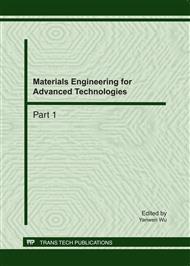p.352
p.357
p.363
p.369
p.375
p.381
p.387
p.393
p.397
Random Fatigue Cracking Thresholds of China Railway Grade B Cast Steel Wheel
Abstract:
Fracture surface observations and statistical deriving are applied experimentally for the present investigation on random fatigue cracking thresholds of China grade B cast steel wheel. Results reveal that: the crack grows with relative regular initial tip companied fabric like stripes along the growth direction but few of fatigue striations and then, cleavage flowers appearing on the district of transient fracture with few of dimples. This indicates that sharp notched structures may be subjected to a little plastic dissipation process. In the same time, non-linear statistical modeling is constructed for describing the random crack growth and then, random fatigue cracking thresholds are measured at specified growth rate. The measurements hold a same growth rate which can not be obtained directly from test results.
Info:
Periodical:
Pages:
375-380
Citation:
Online since:
June 2011
Authors:
Keywords:
Price:
Сopyright:
© 2011 Trans Tech Publications Ltd. All Rights Reserved
Share:
Citation:


